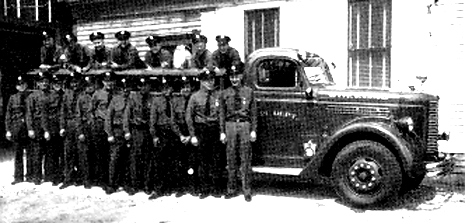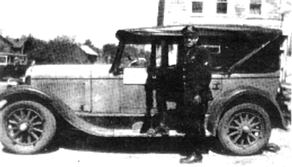|
Fire Department
A
ccording to information researched
compiled by Joan Heuer, and
and presented by the Wheeling
Independent in a series called,
"The Infant Wheeling", the first
move toward fire protection was
made on April 6, 1896.
On that date, a committee of three was appointed to investigate the subject of
fire protection and its estimated cost. This committee had accomplished nothing
by June, so another committee of three was selected to investigate various
chemical and other fire extinguishers and report at the next meeting of the Village
Board. The committee consisted of Mr. Metz, John Forke, and Wm. Fassbender.
Following the recommendations of these men, the Board ordered certain equipment,
and on Septembr 11, 1896, it was delivered at the Wisconsin Central Railway freight office.
The Fire Department was to be allowed the use of the Village Hall for their meetings, and
a fire bell was purchased from Fassbender and Arnold for $27.40.
|
  |
|
 |
| Pictured above are Wheeling's Finest in 1949. Edward Gieseke, Jr., front row - right, was Fire Chief. |
|
  |
|
The
Constitution and By-laws of the Wheeling Fire Department, as adopted on
September 30, 1896, allowed for the following fire bell signals: Regular
or Special Meetings - ringing of bell and three strikes of alarm hammer;
Company's practice - ringing of bell and five strikes of alarm hammer; the Village.
Fire alarm - continuous fast rapping of the bell, then signal for the divisions of
The Divisions of the Village and signals were: From the Southern line to crossing of Mr. E. Wagner's
residence - ringing of bell and one strike of alarm hammer; From center of Village to corner of Dundee Road -
ringing of bell and two strikes of alarm hammer; From corner of Dundee Road to Northern line - three strikes
of alarm hammer; From corner of Dundee Road West - four strikes of alarm hammer.
Andrea's History of Cook County, published in 1894, said of Wheeling: "The chief events of importance
in the recent history of the place have been the prosecution of various parties for the illegal selling of
intoxicating drinks by George Strong, on of the oldest settlers of the town, and a strong foe of
intemperance". This quotation evidently referred to the Township of Wheeling, rather than to the town itself.
The above statement may have been true when considered in the context of world affairs, buy the slow
progress of the town proved to be an asset in the long run. This slowness of growth allowed for the building
of a very stable base upon which the building boom of the 1950's would depend for its strength and guidance.
During the years around the turn of the century, Wheeling would have to be considered as the typical country
town; however, building did continue, and in the surrounding countryside, the farmers were using "modern"
equipment to raise the foodstuffs which helped to sustain the burgeoning metropolis of Chicago.
|
  |
|
 |
| Wheeling's first police car.(1925) |
|
  |
| |
The first officers of The Wheeling Volunteer Fire Department consisted of the following: Mr. Christ F. Metz, Fire Marshall; J.A. Schminke, Asst. Fire Marshall; Frank Forke, Second Asst. Fire Marshall; W.R. Munhenke,
Secretary; W. Riswig, Wm. Fassbender and Tony Behm, Foremen of the various companies. According to the record of minutes of the meetings of the Department, Mr. Reinhold Schneider assumed the duties of Secretary at the
meeting of April 23, 1900, and held the post until the 8th of August, 1927.
In 1904, a hand pumber was purchased to augment the fire fighting equipment. This pumper has been preserved and is on display in the Historical Society Museum.
At the inception of the Fire Department most of the towns prominent citizens participated as Volunteers. The tradition has continued throughout the years and into the present. Wheeling's Volunteer Fire Department has the reputation of being on of the best in the country.
The present Fire Chief, Mr. Bernie Koeppen, is a descendant of one of Wheeling's Pioneers, Mr. Friedrich Koeppen. |
| |
|

|
|






